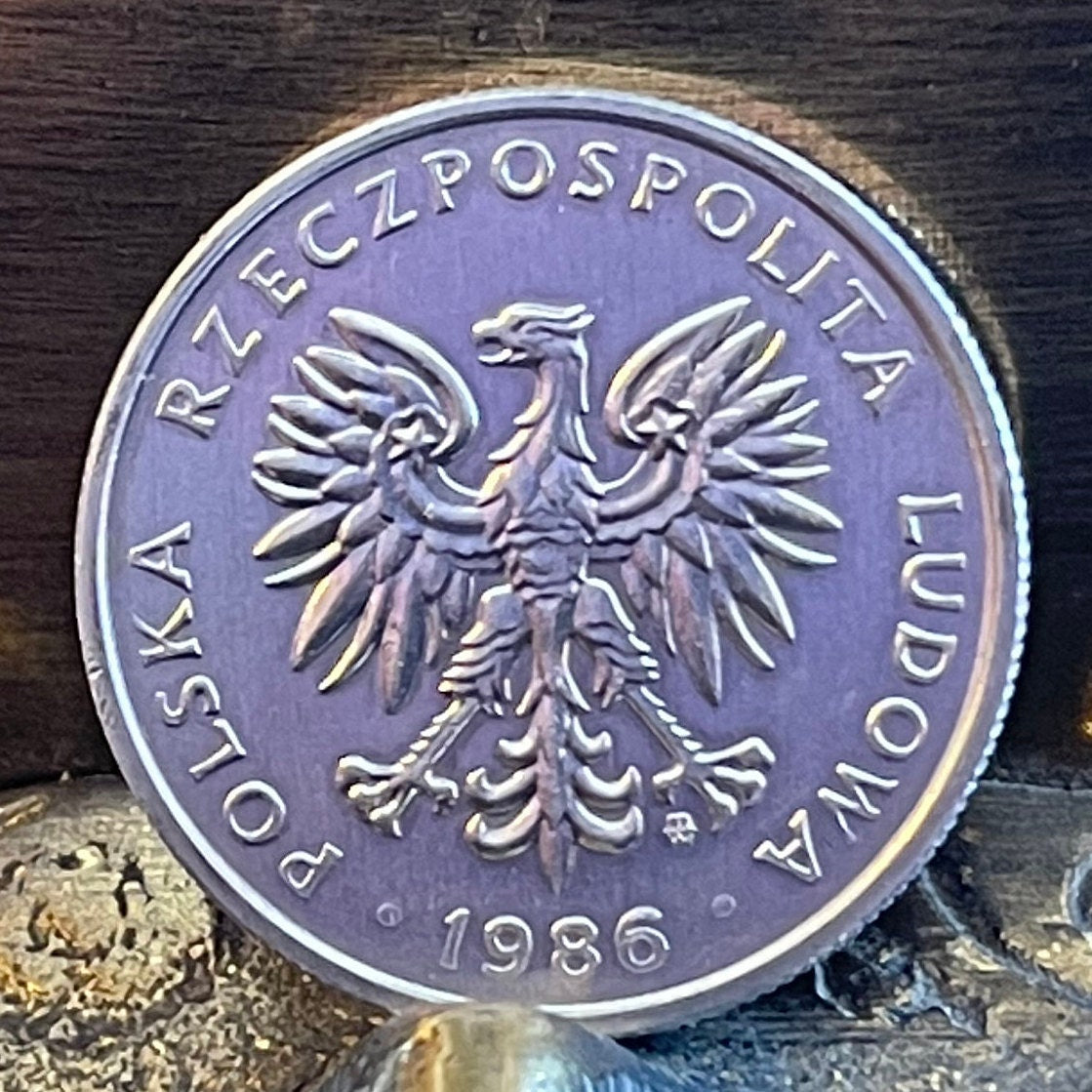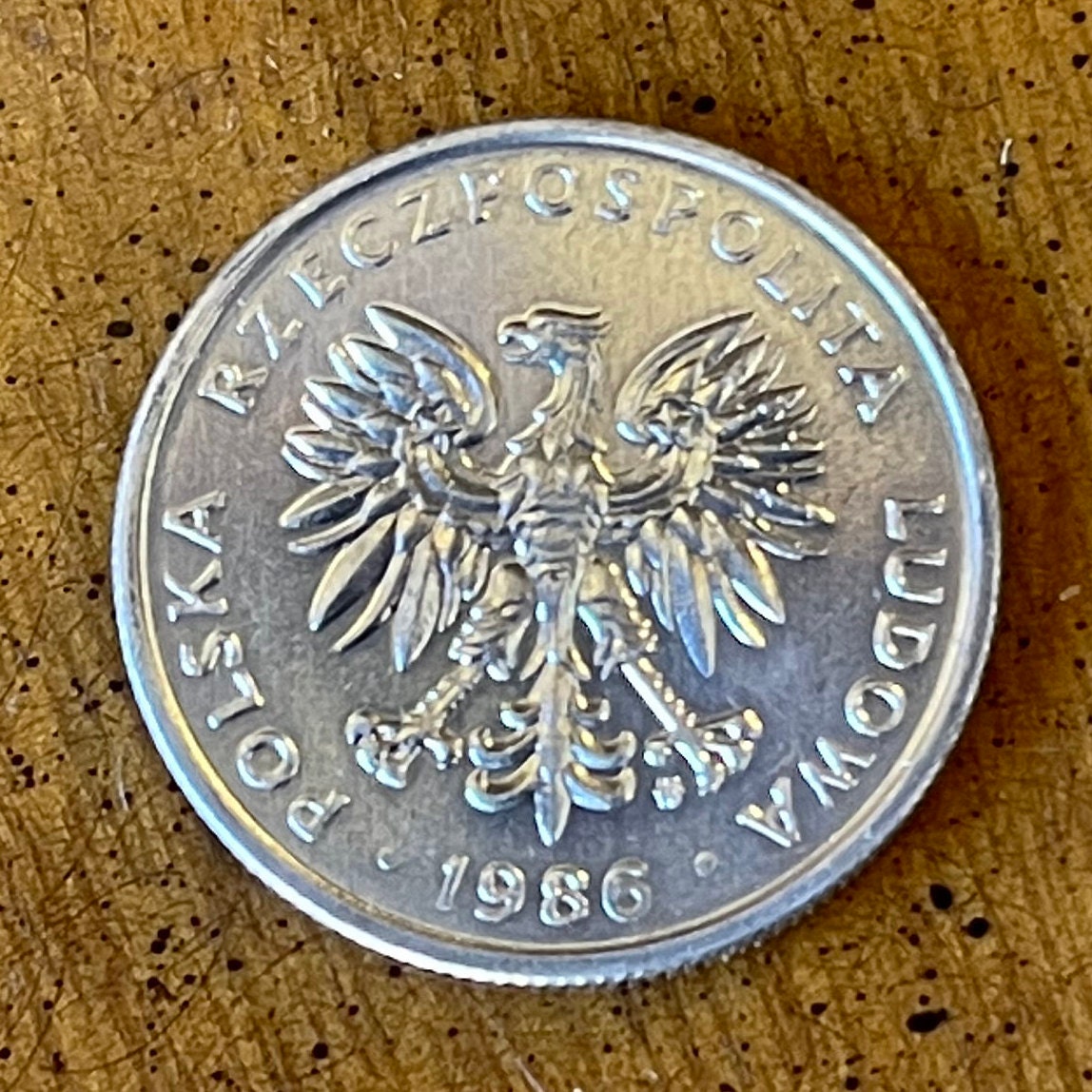elemintalshop
White Eagle 50 Groszy Poland Authentic Coin Money for Jewelry and Craft Making
White Eagle 50 Groszy Poland Authentic Coin Money for Jewelry and Craft Making
Couldn't load pickup availability
White Eagle Poland 50 Groszy Authentic Coin Charm for Jewelry and Craft Making
Obverse
Lettering:
POLSKA RZECZPOSPOLITA LUDOWA
Translation: Polish People`s Republic
Reverse
Lettering:
50
GROSZY
Features
Issuer Poland
Period People's Republic (1952-1989)
Type Standard circulation coin
Years 1986-1987
Value 50 Groszy (0.5 PLZ)
Currency Third złoty (1949-1994)
Composition Aluminium
Weight 1.6 g
Diameter 23 mm
Thickness 1.7 mm
Shape Round
Technique Milled
Orientation Medal alignment ↑↑
Demonetized Yes
Number N# 117983
References Y# 48.2, Par# 211, Fischer Po# OB036, Schön# A145
Wikipedia:
According to legend, the White Eagle emblem originated when Poland's legendary founder Lech saw a white eagle's nest. When he looked at the bird, a ray of sunshine from the red setting sun fell on its wings, so they appeared tipped with gold, the rest of the eagle was pure white. He was delighted and decided to settle there and placed the eagle on his emblem. He also named the place Gniezdno (currently Gniezno) from the Polish word gniazdo ("nest").
The symbol of an eagle appeared for the first time on the coins made during the reign of Bolesław I (992-1025), initially as the coat of arms of the Piast dynasty. Beginning in the 12th century, the eagle has appeared on the shields, ensigns, coins, and seals of the Piast dukes. It appeared on the Polish coat of arms during Przemysł II reign as a reminder of the Piast tradition before the fragmentation of Poland.
The eagle's graphic form has changed throughout centuries. Its recent shape, accepted in 1927, was designed by professor Zygmunt Kamiński[6] and was based on the eagle's form from the times of Stefan Batory's reign. It was adapted to stamps or round shields rather than to a rectangular shape.
The arms of the Polish–Lithuanian Commonwealth was quartered, with Polish eagle and Lithuanian Pahonia on opposite sides. Kings used to place their own emblems in the center of the national coat of arms (i.e., House Vasa).
Despite the fact that new emblems were given to provinces established by the invaders after the partitions of Poland, the White Eagle remained there with or without crown and occasionally with face turned towards left and in some exceptions with Pahonia. But in most cases they were combined with the invader's emblem.
The Poles conscientiously collected coins from the pre-partitions period with the eagle on their obverse and reverse. The symbol of the eagle, often with Pahonia, appeared on numerous flags and emblems of the November Uprising.
The resurrection of the Polish Kingdom (Polish Regency) in the territories of the former Congress Poland (which had been partitioned and annexed by the Russian Empire as the Vistula Land in 1867) was approved by Austria-Hungary and Wilhelm II's Germany in 1916. A year later, the first Polish banknotes (Polish Marka) with Crowned Eagle on an indivisible shield were introduced. After regaining total independence and the creation of the Second Polish Republic (1918–1939) the White Eagle was implemented by the act of 1919. Official image of the coat of arms (which resembled the emblem of Stanislaus Augustus) was used until 1927 when Zygmunt Kamiński designed a new one. According to the research of Polish heraldist Jerzy Michta published in 2017, the version designed by Kamiński was actually plagiarized from a 1924 medal by Elisa Beetz-Charpentier made in honor of Ignacy Paderewski.
After World War II, the communist authorities of the Polish People's Republic removed the "reactionary" royal crown from the eagle's head. Still, Poland was one of the few countries in the Eastern Bloc with no communist symbols (red stars, ears of wheat, hammers, etc.) on either its flag or its coat of arms. The crownless design was approved by resolution in 1955. To counter that, the Polish government in Exile introduced a new emblem with a cross added atop the crown. After the fall of communism in 1989, the crown came back, but without the cross.
The eagle appears on many public administration buildings, it is present in schools and courts. Furthermore, it is placed on the obverse of Polish coins. However the issue on which conditions it should be exposed and how it should be interpreted is the topic of numerous debates in Poland. The eagle was formerly on the Poland national football team's shirts; a new shirt without the eagle was introduced in November 2011, prompting complaints from fans and president Bronisław Komorowski. Due to this overwhelming public pressure, the football shirts were redesigned with the eagle reinstated in the centre of the shirt in December 2011.
Share










5 stars review from Catherine
It's not easy coming up with unique reviews for everything I ordered from this shop, considering each item I recieved is great. Expectations exceeded, a nice clean coin. Quick delivery and well packaged!
5 stars review from Kell









